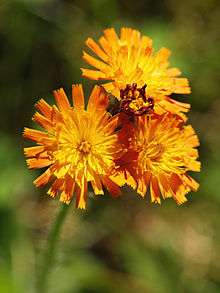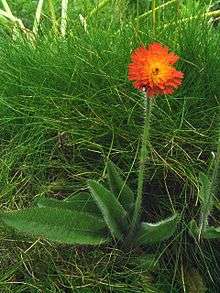Pilosella aurantiaca
| Pilosella aurantiaca | |
|---|---|
 | |
| Scientific classification | |
| Kingdom: | Plantae |
| (unranked): | Angiosperms |
| (unranked): | Eudicots |
| (unranked): | Asterids |
| Order: | Asterales |
| Family: | Asteraceae |
| Tribe: | Cichorieae[1] |
| Genus: | Pilosella |
| Species: | P. aurantiaca |
| Binomial name | |
| Pilosella aurantiaca (L.) F.W.Schultz & Sch.Bip.[2][3] | |
| Synonyms | |
|
Hieracium aurantiacum L. | |
Pilosella aurantiaca (fox-and-cubs, orange hawkweed,[4]:208 tawny hawkweed, devil's paintbrush, grim-the-collier) is a perennial flowering plant in the daisy family Asteraceae native to alpine regions of central and southern Europe, where it is protected in several regions.
Description
It is a low-growing plant with shallow fibrous roots and a basal rosette of elliptical to lanceolate leaves 5–20 cm long and 1–3 cm broad.[5] All parts of the plant exude a milky juice. The flowering stem is usually leafless or with just one or two small leaves. The stem and leaves are covered with short stiff hairs (trichomes), usually blackish in color. The stems may reach a height of 60 cm and have 2–25 capitula (flowerheads), each 1–2½ cm diameter, bundled together at the end of short pedicels. The flowers are orange, almost red, which is virtually invisible to bees, yet they also reflect ultraviolet light, increasing their conspicuousness to pollinators.[6] The flowers are visited by various insects, specifically Musca flies.[6] The flowers themselves come in a range of colors from a deep rust-orange to a pure yellow and often show striking gradients of color.
The plant propagates through its wind-dispersed seeds, and also vegetatively by stolons and shallow rhizomes.
Cultivation and uses

P. aurantiaca is widely grown as an ornamental plant in gardens for its very decorative flowers. It has been introduced into Australasia and North America and escaped from gardens and is considered an invasive species in some areas. It is found across Canada and the north of the U.S., reaching more in the south on the coasts. The plant is easily removed (until it seeds back) by ploughing or salting, and it cannot be controlled by mowing because it regularly reproduces vegetatively. It is on the noxious weeds and/or quarantine lists of Colorado,[7] Idaho,[8] Montana,[9] Oregon,[10] Washington,[11] and regions of British Columbia,[12] with cultivation usually prohibited. In Alberta, it is not considered a noxious weed except locally.[13] In Australia, the plant is considered a noxious weed in Tasmania and it is quarantined from the country.[14] It has been recorded at Kosciuszko National Park in New South Wales, Falls Creek and Mount Buller in Victoria and Fern Tree and Snug in Tasmania.[15] In New Zealand, the plant is closely watched[16] and attempts at control are made.
References
| Wikimedia Commons has media related to Pilosella aurantiaca. |
| Wikispecies has information related to: Pilosella aurantiaca |
- ↑ "Asteraceae tribe Cichorieae". Flora of North America.
- ↑ Bräutigam, S; Greuter, W (2007). "A new treatment of Pilosella for the Euro-Mediterranean flora". Willdenowia. 37 (1): 123–137. doi:10.3372/wi.37.37106.
- ↑ Schultz, FW; Schultz-Bipontinus, CH (1862). "Pilosella als eigene Gattum aufgestellt". Flora (Separatabdruck). 45: 417–441.
- ↑ Peterson, Roger Tory; McKenny, Margaret (1968). A Field Guide to Wildflowers of Northeastern and North-Central North America. Houghton Mifflin Company Boston. ISBN 0-395-18325-1.
- ↑ Blanchan, Neltje (2005). Wild Flowers Worth Knowing. Project Gutenberg Literary Archive Foundation.
- 1 2 Van Der Kooi, C. J.; Pen, I.; Staal, M.; Stavenga, D. G.; Elzenga, J. T. M. (2015). "Competition for pollinators and intra-communal spectral dissimilarity of flowers" (PDF). Plant Biology. doi:10.1111/plb.12328.
- ↑ "Colorado Noxious Weeds ID Guide".
- ↑ Robert H. Callihan & Timothy W. Miller (2004). "Idaho's Noxious Weeds – Orange Hawkweed". The Idaho Association of Soil Conservation Districts.
- ↑ Montana's Statewide Noxious Weed Awareness and Education Campaign. "Weed list".
- ↑ "Noxious Weed List by common name". Oregon Department of Agriculture.
- ↑ "Orange hawkweed (Hieracium aurantiacum". Washington State Noxious Weed Control Board.
- ↑ Field Guide to Noxious and Other Selected Weeds of British Columbia (2002). "Orange Hawkweed (Hieracium aurantiacum)". Ministry of Agriculture and Lands.
- ↑ Alberta Invasive Plants Council. "Orange Hawkweed: Hieracium aurantiacum" (PDF). Government of Alberta.
- ↑ Department of the Environment and Heritage and the CRC for Australian Weed Management (2003). Orange hawkweed (Hieracium aurantiacum). ISBN 1-920932-25-9.
- ↑ "Hieracium aurantiacum". Weeds in Australia. Department of the Environment (Australia). Retrieved 31 October 2013.
- ↑ Biosecurity New Zealand. "Pests and Diseases List".